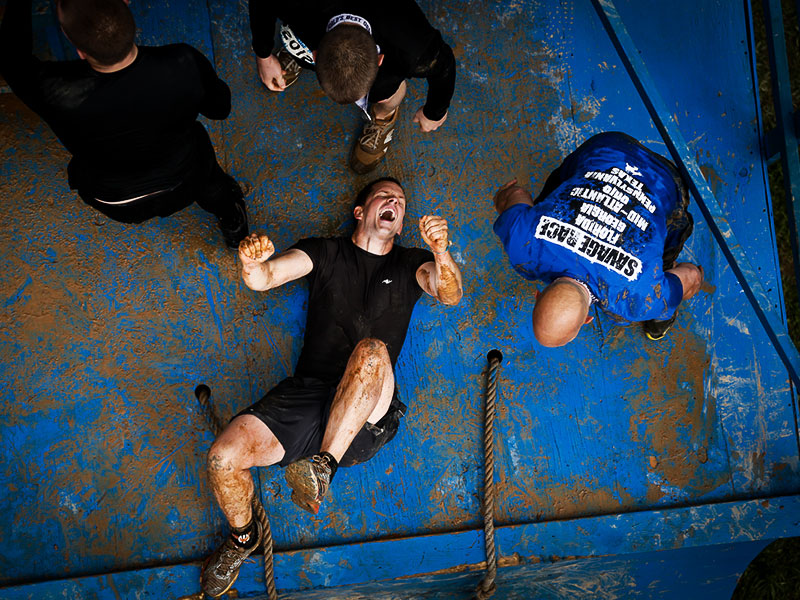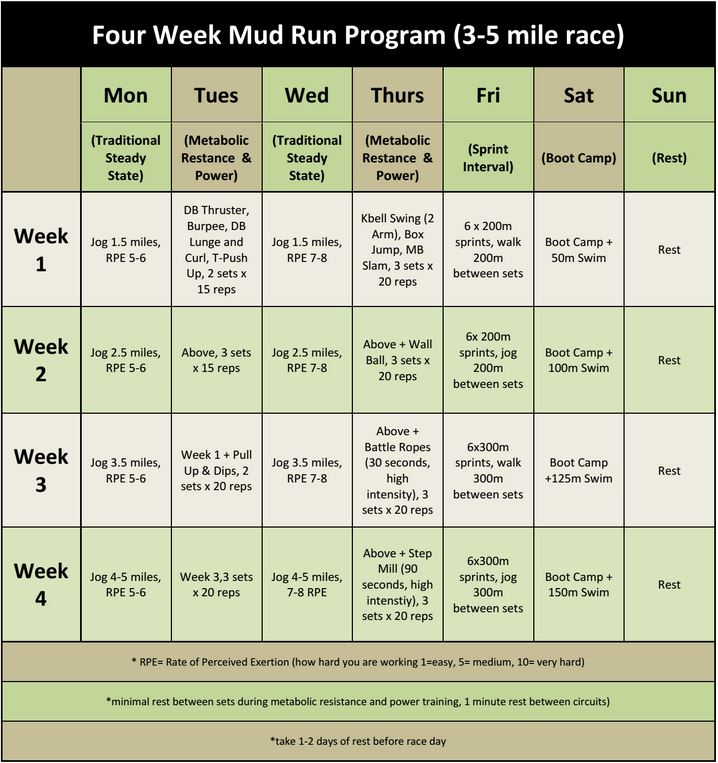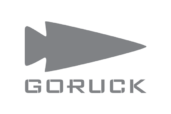-Sam Abbitt, CEO and Co-Founer of Savage Race
Mud Run Training – Savage Race
People ask us all the time how to train for mud runs and obstacle races like Savage Race. The answer that I used to always give people was to “Pick four or more of the following activities and repeat them regularly: run, swim, lift heavy things, climb over walls, get plenty of sleep and eat clean.” It’s an easy answer, but sort of a smart assed cop out on my part. Well, for those of you who want more specific direction than that, you’re in luck. Our friends at Sweat Life Fitness (who regularly kick ass at our Savage Race events) designed a mud run training program for Savage Race. The goal here is to work your way up to completing the Savage Rite of Passage. If you can get it done, you’re ready!
Mud Run Training by Art Waters, MS, CSCS, NASM and Chris Pregony, BS, ACSM
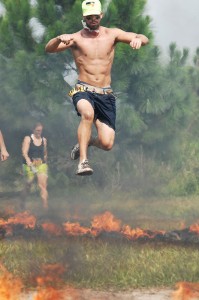 If you plan on getting your ass kicked by the Savage Race, you probably should at least consider putting up a fight. In order to get you prepared for the massacre, we have provided you with four training modalities you must utilize (Steady State Running, Sprint Interval Running, Outdoor Boot Camp Training, and Metabolic Resistance & Power Training). Also, we have created a four-week training program (some individuals may require more training time) and a Rite of Passage Challenge to test your might. We recommend the seasoned veteran complete the Challenge for time, partake in the four-week training program, then retest the Challenge to gauge progress. However, we advise the novice to complete the entire four-week training program before attempting the Challenge. There are two Challenges available. Option one requires no equipment, while option two requires a few pieces of equipment as well as somewhere to swim. Finally, we suggest you reference our 15 Savage Threats to help get you mentally prepared for the race.
If you plan on getting your ass kicked by the Savage Race, you probably should at least consider putting up a fight. In order to get you prepared for the massacre, we have provided you with four training modalities you must utilize (Steady State Running, Sprint Interval Running, Outdoor Boot Camp Training, and Metabolic Resistance & Power Training). Also, we have created a four-week training program (some individuals may require more training time) and a Rite of Passage Challenge to test your might. We recommend the seasoned veteran complete the Challenge for time, partake in the four-week training program, then retest the Challenge to gauge progress. However, we advise the novice to complete the entire four-week training program before attempting the Challenge. There are two Challenges available. Option one requires no equipment, while option two requires a few pieces of equipment as well as somewhere to swim. Finally, we suggest you reference our 15 Savage Threats to help get you mentally prepared for the race.
I. Traditional Steady State Running
What: Traditional steady state running is a jog or run that you complete while maintaining the same speed throughout. There is no intentional change of running speed during this type of training.
Why: Although traditional steady state running has come under fire recently, we feel that it is incredibly important for your training. Competitive distance runners have to run high volumes in order to be successful in their various races. You cannot expect to do well in a mud RUN if you do not practice running. Traditional steady state running has proven to improve VO2 max (the amount of oxygen your body can uptake and utilize), decrease resting heart rate, and increase mitochondrial bodies in skeletal muscle. All of these physiological adaptations cause you to become more efficient in your running.
II. Sprint Interval Training
What: Sprint interval training is a method in which you run a designated distance or time at maximal or near maximal effort followed by a recovery period at a lesser intensity. This sequence is repeated numerous times as prescribed. Sprint interval training is easiest to perform at a track since running distances can be measured easily and you will not have to worry about obstacles. We realize that you will have many obstacles during the course; however, we feel the track environment is very safe and will allow you to train at maximum velocities.
Why: Sprint interval training is one of the best ways to 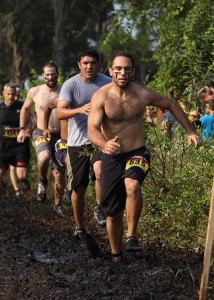 improve your running because it will not only increase your speed and endurance, it can improve your running form as well. Expect your VO2 max to increase (remember the more oxygen you can process the better- the average runner’s max is around 54ml/kg/min; Lance Armstrong’s is around 84ml/kg/min). Another physiological adaptation you can expect is an increase in your body’s lactate threshold (LT). Basically, LT is the point where the blood lactate levels accumulate faster than they are removed in your body and become so high that your body will shut down. That is the burning feeling you get when you sprint. By doing short sprints you can increase this level and in turn, be able to run harder for longer.
improve your running because it will not only increase your speed and endurance, it can improve your running form as well. Expect your VO2 max to increase (remember the more oxygen you can process the better- the average runner’s max is around 54ml/kg/min; Lance Armstrong’s is around 84ml/kg/min). Another physiological adaptation you can expect is an increase in your body’s lactate threshold (LT). Basically, LT is the point where the blood lactate levels accumulate faster than they are removed in your body and become so high that your body will shut down. That is the burning feeling you get when you sprint. By doing short sprints you can increase this level and in turn, be able to run harder for longer.
III. Outdoor Boot Camp Training
What: Boot camps are typically outdoor group training classes that consist of exercises that focus on muscular endurance, agility, and cardiovascular fitness.
Why: The first reason these classes are key in mud run training is that they are outside! Many people make the mistake of training on a treadmill and never learn to deal with the outdoor elements that are part of mastering a mud run. Some of the potential elements include heat, humidity, cold air, wet grass, mud, uneven terrain, hills, etc. In addition to being outside, boot camps typically involve performing an exercise followed by running. This closely mimics what happens at races. Most mud runs will have an obstacle followed by running, then another obstacle. Boot camps aren’t much different. They typically consist of something like 15 burpees, 20 push ups, 30 yard bear crawl, and a 50 yard sprint. This type of training forces you to coordinate multiple muscle groups and joints followed by running. The principle of specificity says that when training for an event you should do things that are the same or similar to the event you are training for, therefore boot camps are paramount.
IV. Metabolic Resistance and Power Training
What: Metabolic resistance and power training consists of lifting, jumping, swinging, pulling, pushing, pressing, slamming and throwing. Some of the equipment you can expect to use includes Dumbbells, Barbells, Kettlebells, Plyometric Boxes, and Medicine Balls. This training usually takes place inside of a studio, gym, warehouse, or garage setting. You technically could perform these movements outdoors, but we usually see them performed indoors. You can expect to have a pair or group of exercises combined which you complete in a circuit fashion. Repetitions are usually high (10+) and rest is limited. These training sessions can take anywhere from 30-60 minutes.
Why: Because metabolic resistance and power training will have you performing big (multiple joints/muscle groups) movement patterns with little to no rest you can anticipate feeling many benefits. Some of the relevant changes in relation to the mud runs include increased VO2 max, decreased body fat, and increase in muscle size and strength. With the increase in strength and muscle mass you will be able to climb walls, carry sand bags, pull cinder blocks, and complete any other strength obstacle easier. Also, by performing some movement patterns explosively, your power output will be greater. Therefore, you will be able to jump higher, move more quickly, and run faster.
Putting It All Together
Listed below you will find a sample four week training program that includes traditional steady state running, sprint interval running, boot camp training, and metabolic resistance and power training. We have provided detailed workouts for each modality, except for boot camp training because these classes vary greatly and include many movement patterns. We encourage you to research boot camp classes in your local community, they should not be hard to find as they are very popular and economical. The metabolic resistance and power programs are themed in two ways. The first training session of the week focuses more on strength, whereas the second training session focuses more on power. We attempted to keep the exercises pretty basic and equipment used somewhat minimal. If you do not have access to any of the equipment, please give us a call or shoot us an email so that we can recommend alternate exercises. Now it is time to get training, you have all of the tools to be successful! Good luck and stay tuned for our final blog of the series, Get Your Mud On, Fueling the Body!
The Savage Rite of Passage Challenge
If you can complete one of the following challenges without taking excessive breaks or throwing up, you are ready for Savage Race!
Option 1 (no equipment):
20 Push Ups
30 Mountain Climbers (15 each side)
25 yard Bear Crawl (to first line)
8 Burpees
125 yard Run (50 yds to last line, turn around and run 75 yds back to the starting line)
Repeat circuit 10x for time
Option 2 (some equipment required):
Burpees x 15 /Run .25 mile
Ice Skaters x 15 each/Run .25 mile
Muscle Ups x 3/ Run .25 mile
Farmer’s Walk x 50 yards @ .50 body weight/Run .25 mile
Box Jump x 15 @ 20”/ Run .25 mile
Plank to Push Up x 15/ Run .25 mile
Standing Mountain Climbers x 15 each/ Run .25 mile
Stair Climb x 4 floors/ Run .25 mile
Mountain Climbers x 15 each/ Run .25 mile
Pull Up x 10/ Run .25 mile
Split Jumps x 10 each, Run .25 mile
Swim x 150 meters, Run . 25 mile
Lunges in Place x 10 each/ Run .25 mile
Broad Jump x 10/ Run .25 mile
Superman x 20/ Run .25 mile
Bear Crawl 25 yards/ Sprint 100 yards
Complete 1x for time
15 Savage Threats
1) Mud: thick, stinky, deep, sluggish, drawer -filling, and shoe sucking
2) Tires: some swinging for your dome and some stat ionary at your feet
3) Hills: lots of switch backs and sand , be patient
4) 96” Stiffie: Savage Race’s description of the giant orange wall…phone a friend or muster up some upper body strength and leaping ability
5) Hay: get your grub on or navigate over
6) Smaller Stiffies: sorry, not all of the walls can be big but they still can zap your energy
7) Sand Bags: these bags get heavy quick when you are tired, try to carry on your back or over a shoulder
8) Cargo Nets: climb and balance, be careful not to get a limb stuck or fal l off of the top
9) Water: slip n slide is fun, but beware of the 150 meter swim
10) Ice: expect to be shocked and allow time for your muscles to fire properly after exiting
11) Incline Walls: keep your footing while firmly pulling up the rope, be careful on the back side as you descend
12) Fire: hop over and enjoy the smell of your singed leg hair
13) Barbed Wire: crawl under and stay low
14) Monkey Bars: ask your kids for help on this one
15) Surprises: Savage folks are kind of crazy so keep an open mind and good luck
Art Waters, MS, NSCA-CSCS, NASM -CES is a Master Trainer at Sweat Life Fitness, Inc. in Gainesville, FL. He can be reached at art(at)sweatlifefitness(dot)com for more information and training consultations.
Chris Pregony, BS, ACSM-HFS, is a Master Trainer at Sweat Life Fitness, Inc. in Gainesville, FL. He can be reached at chris(at)sweatlifefitness(dot)com for more information and training consultations.
Sweat Life Fitness, Inc.
Haile Plantation Village Center
5206 SW 91st Terrace, Suite A
Gainesville, FL 32608
352-692-4926
www.sweatlifefitness.com
We always appreciate and welcome your feedback and comments. Live the Sweat Life!
originally posted on 06/07/2012



